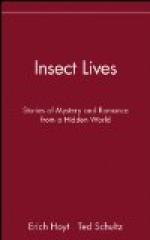To explain satisfactorily these complex life-stories is however admittedly a difficult task. The acquisition of wings is, as we have seen, a dominating feature in them all, but if we try to go yet a step farther back and speculate on the origin of wings in the most primitive exopterygote insects, the task becomes still more difficult. Many years ago Gegenbaur (1878) was struck by the correspondence of insect wings to the tracheal gills of may-fly larvae, which are carried on the abdominal segments somewhat as wings are on the thoracic segments. But Boerner has recently (1909) brought forward evidence that these abdominal gills really correspond serially with legs. Moreover Gegenbaur’s theory suggests that the ancestral insects were aquatic, whereas the presence of tubes for breathing atmospheric air in well-nigh all members of the class, and the fact that aquatic adaptations, respiratory and otherwise, in insect-larvae are secondary force the student to regard the ancestral insects as terrestrial. It is indeed highly probable that insects had a common origin with aquatic Crustacea, but all the evidence points to the ancestors of insects having become breathers of atmospheric air before they acquired wings. How the wings arose, what function their precursors performed before they became capable of supporting flight, we can hardly even guess.
Our study of the life-story of insects, therefore, while it has taught us something of what is going on around us to-day, and has given us hints of the course of a few threads of that long life-story which runs through the ages, brings us face to face with the most instructive, if humbling fact that ’there are many more things of which we are ignorant.’ The passage from creeping to flight, as the caterpillar becomes transformed into the butterfly, was a mystery to those who first observed it, and many of its aspects remain mysterious still. Perhaps the most striking result of the study of insect transformation is the appreciation of the divergent specialisation of larva and imago, and it is a suggestive thought that of the two the larva has in many cases diverged the more from the typical condition. The caterpillar crawling over the leaf, or the fly-grub swimming through the water, may thus be regarded as a creature preparing for a change to the true conditions of its life. It is a strange irony that the preparation is often far longer than the brief hours of achievement. But the light which research has thrown on the nature of these wonderful life-stories, the demonstration of the unseen presence and growth within the insect, during its time of preparation among strange surroundings, of the organs required for service in the coming life amid its native air, confirm surely the intuition of the old-time students, who saw in these changes, so familiar and yet so wonderful, a parable and a prophecy of the higher nature of man.




